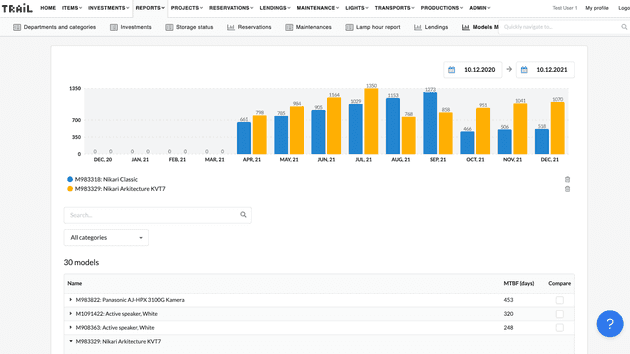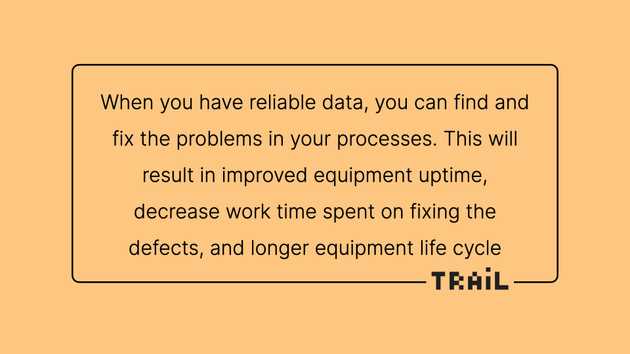What does MTBF mean?
MTBF is an acronym for Mean Time Between Failures. As the name suggests, MTBF means the mean time between two separate failure or defect incidents on a single device or a device model.
It is a crucial key performance indicator (KPI) for equipment management. MTBF allows to evaluate how equipment is being used or maintained and to act accordingly. For example, if the MTBF differs significantly between two identical devices, it means that there is something wrong in one of the devices or in its usage.
Larger MTBF value indicates longer time between failures. Likewise, smaller value indicates that the item suffers from defects more often.
MTBF analytics in Trail Equipment Management
Equipment maintenance is one of the key functionalities of Trail. To support maintenance management, we released MTBF analytics feature both for item models and individual items to Trail.
Possibility to report defects for equipment has always been in the core of Trail. Trail bases the MTBF value on the time interval between two consequent defect reports and presents the value in days.
MTBF for models
Models' MTBF value shows the mean time between failures for the items in the same model. Trail's model based MTBF report also allows users to compare different models' MTBF with each other.
Users can select the models they want to compare with each other. The graph helps users to understand the differences in the MTBF value between the selected models.
Comparing different models gives excellent insight for, i.e., making better purchase decisions. By comparing the MTBF value, you can recognise the models that are more reliable than their alternatives.
The model MTBF is also an important reference point for the item based MTBF.
Item based MTBF
From equipment management and especially maintenance management point of view, the item based MTBF is more important than the model based MTBF. Item based MTBF tells you the mean time between failures on a single item level.
By comparing the item based MTBF value to the MTBF value of identical items, users gain valuable data of the item. If the item based MTBF value is significantly lower than its model's MTBF, it tells that this particular item has more frequent fault incidents than other identical items.
Data of these anomalies allow users to investigate the underlying reasons for the differences. For example, more frequent defects may result from improper use or imperfect maintenance. It might also signal that the item itself is faulty and should be renewed.
When you have reliable data, you can find and fix the problems in your processes. This will result in improved equipment uptime, decrease work time spent on fixing the defects, and longer equipment life cycle.
Summary
MTBF stands for Mean Time Between Failures. It is an item or model based value that indicates the mean time between two separate defect incidents in a single item or an item model.
It is not the best indicator for predicting the next fault situation. However, it works best for analysing individual items and their performance. If an item's MTBF differs from other identical item's MTBF, it tells that there is something wrong with the item itself, its usage or in its maintenance.
When you notice anomalies in MTBF early, you have the chance to find out the reasons for them and act accordingly. With the reliable MTBF data, you can ensure that the problems are fixed on time and thus decrease the item downtime and maintenance costs, and increase the item life cycle.
Trail Equipment Management provides you with all the necessary tools for managing equipment, equipment maintenance, and analysing the mean time between failures for items and item models.
If you are interested in learning more, please contact us!
You might be also interested in the Best Practices of Equipment Management: Effortless Maintenance Planning and Easy Defect Reports

